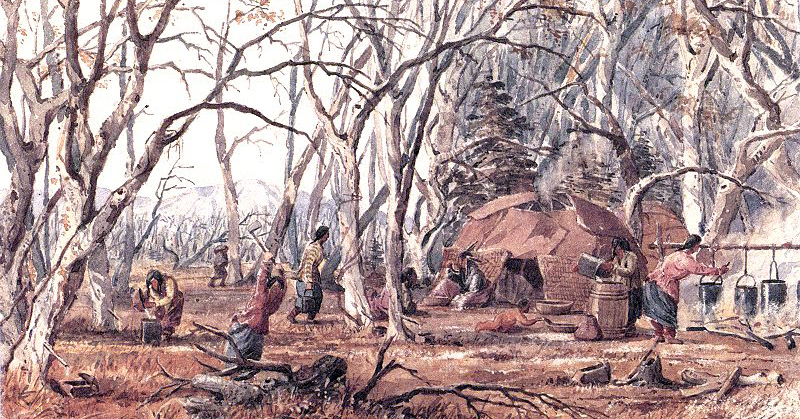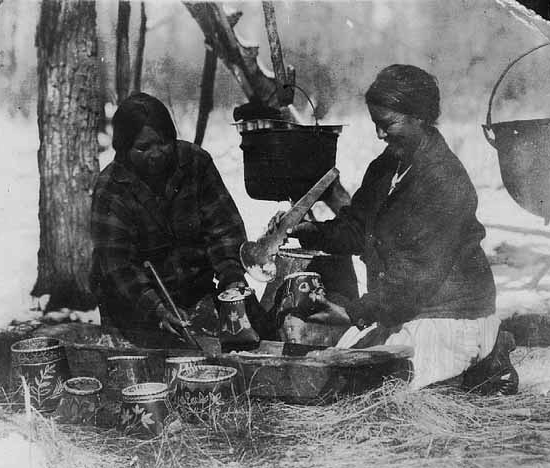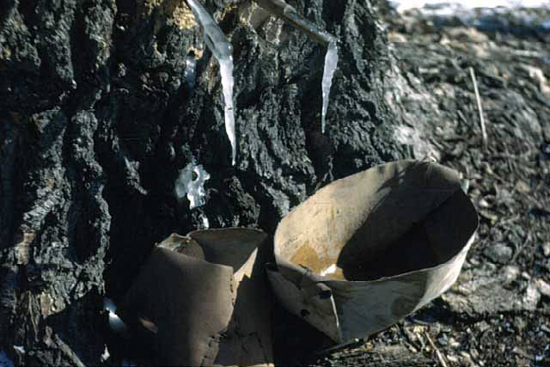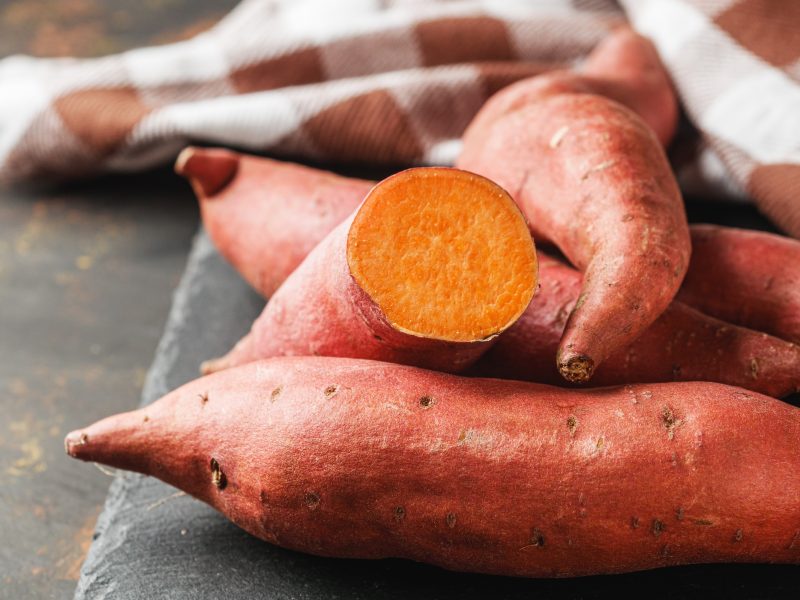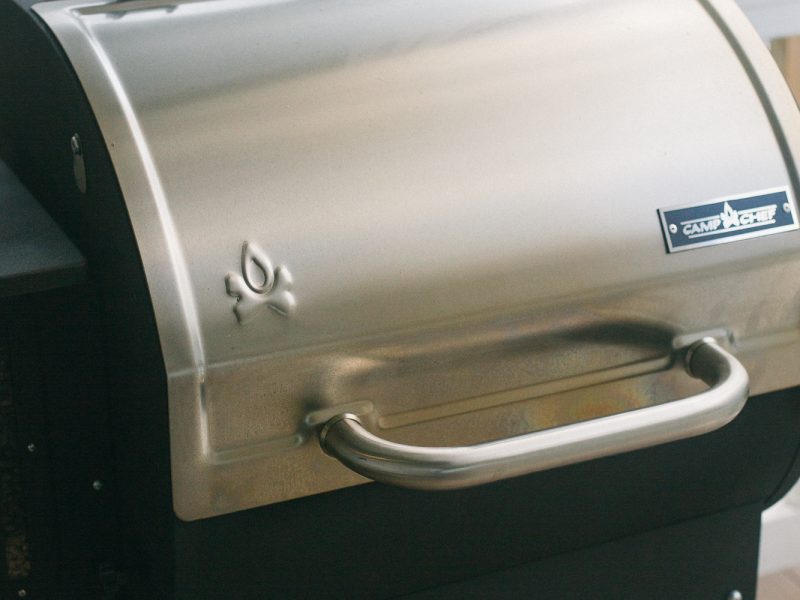
Hi everyone, Andrew here with another food history post. I’m originally from Upstate New York, where maple syrup is kind of a big deal. My family has always had a special fondness for the stuff. The “pancake syrup” made of corn syrup was completely unknown in my house. We only used the real stuff, but sparingly (it’s so sweet!). Maple sugar candy was a favorite treat—but again—only in small amounts. A single 1/3 ounce leaf-shaped candy was enough. My parents live 20 minutes from Toad Hill Maple Farm, and they mail us their maple products now that we live out West. Kelly thinks the maple sugar candy is too sweet, but we all enjoy a little maple syrup on our pancakes.
A few years ago I was excited to find a very early account of maple sugaring in the book David Zeisberger’s History of the Northern American Indians. A Moravian missionary, Zeisberger lived with Lenape people in the western Pennsylvania and Ohio wilderness between 1766 and 1781. His journal describes their day-to-day life of this Indian tribe that is often called the Delaware. His writing is considered by many to be the best description of 18th century life of the northeastern Native Americans. Zeisberger’s perspective was that of a Christian European man, yet his first-person account of the Indians is as accurate and objective as you will find for this period.
I thought it would be interesting to share this excerpt about maple sugar production by the Lenape. I have added a few notes in brackets. I couldn’t find 18th century art depicting maple syrup production, so I have included more modern images of people using traditional maple sugaring materials.
David Zeisberger’s History of the Northern American Indians
Sugar trees are usually found in low, rich soil, sometimes, also, on higher land and in more northerly regions even on hills, where, however, the soil is very moist. The Delawares call this tree the Achsuntuimunschi, that is, the stone-tree, on account of the hardness of the wood. The Mingoes give it a name signifying the sugar tree, as do the Europeans. From the sap of the tree sugar is boiled. This is done by the Indians in the early part of the year, beginning in February and continuing to the end of March or beginning of April, according as spring is early or late. In this region it is possible to boil sugar even in fall after there has been frost and in winter, if the season is mild. For as soon as the trees thaw a little the sap begins to run and then the trees are tapped. As, however, at that time of the year the weather is very uncertain and it is possible that there should be a cold wave at any time, it is hardly worth the effort to make the necessary arrangements and is hardly ever done, unless some one be driven of necessity to provide sugar for the household. This, we ourselves have been obliged to do and the sisters of our congregation have already boiled a quantity of sugar for congregational lovefeasts, shortly before Christmas.
An Ojibwe woman prepares birch bark containers for collecting maple sap, 1908. Note the wooden wedges driven into the trunk to direct the sap. Photo courtesy of the Library of Congress.
Spring is the proper season for boiling sugar. The following preparations are made. A number of small troughs are made for receiving the sap. Usually, the Indians make them of wood, cutting them out roughly with a hatchet. Some Indians are able to make twenty or thirty of them in a day. Some do not go to so much trouble, but make dishes of the bark or bast of a tree, which serve quite as well, but are good for no more than one season. According as they have large number of kettles and troughs they can make much sugar, for there is no lack of trees. Besides the smaller troughs and dishes, there must be several of larger size in which the sap is collected. If one is well supplied with utensils, there is this advantage, that on days when the sap flows freely much may be collected, which will enable one to keep on boiling when the sap does not flow plentifully. The sap flows most plentifully when it freezes at night and the sun shines during the day. At night it commonly ceases to run. The same is true in case of warm or rainy weather. As soon as there has been frost the sap runs again. There is a time in the boiling season when sap once or twice begins to flow in considerable quantities, both day and night. When this occurs the height of the sugar season is on. The sap which flows after this is not so good and yields less sugar. The last sugar secured in the spring is always of inferior quality. Hence, toward the end of the season no sugar, but only molasses is in most cases boiled.
The length of the season is determined by the weather conditions. If spring is late and night frosts continue for a considerable time, the flowing season is the longer. With the early advent of warm weather the season terminates very quickly. The shortest season lasts about a month, the longest nearly two months. The thickest of the trees are two feet, sometimes more, in diameter. Those of middle size, which are still young, have many branches and are growing, yield the most sap. Experience has shown that such a tree will yield about sixty gallons of sap while sugar is being boiled, and thereafter another sixty for molasses [by “molasses,” he means maple syrup]. Seven to eight gallons of sap are regarded as necessary for a pound of sugar. Such a tree may, therefore, yield more than seven pounds of sugar and seven quarts of molasses. It has also been found that a tree which one year has yielded very freely, gives but little the next, and on the other hand, a tree that has yielded but little one season, gives largely the next.
The sap, which is of a brownish color [maple sap from the tree is clear like water] and becomes darker the longer it boils, is boiled until it gets to be of the consistency of molasses, is then poured off and kept. Where a sufficient quantity of this consistency has been secured, it is boiled over a slow fire until it becomes sugar. It is important to boil this over a slow fire, for the sap readily boils over and is easily burned. If the boiled sap is stirred until cold, the sugar becomes granulated and is as fine as the West Indian sugar [cane sugar]. As the Indians lack the dishes and do not care to take the time to prepare it in this way, they usually form it into cakes, put it in a kettle or dish, or in default of these, on a stone and let it cool, when it becomes hard and may be easily preserved in baskets. If the troughs and kettles used for collecting the sap are made of wood that does not give color, the sugar becomes the finer, but if it gives color, as does the white walnut, the sugar becomes black the first year; thereafter, this is not the case.
Maple sugar was made in wooden troughs as seen in this 1925 photo from Mille Lacs Reservation, MN. Courtesy of MNHS.
When everything is prepared, an oblique incision is made in the tree and at the lower end of the same a thin wedge, three or four inches broad, is forced in, whence the sap runs down into the vessel placed below. According as the sap runs freely or contrarywise, the dishes must be emptied at given intervals, day and night. According to the manner of making the incision one may determine whether a tree shall be good for many or few years. If large openings are made the tree is soon spoiled and nothing is gained, for the sap runs no faster. In this matter, however, the Indians are very careless, for trees are numerous and after they have used one place for three or four years, they seek out another.
A 1947 photo showing traditional wooden spouts (hollowed sumac or elder stems) dripping frozen sap into a birchbark containers, Mille Lacs Reservation, MN. Courtesy of MNHS.
There is, strange to say, no tree among all the rest so hardy as the sugar-tree, for even if the stem is cut all around, so that it can no longer be used, it does not die. Hence, the Indians very reluctantly make their fields where there are sugartrees, as these are not to be exterminated, except they be cut down. This, however, is true that when trees have been used for eight or nine years they give less sap than formerly, as they are full of incisions and scars. An incision having been made in a tree in the spring of the year and the sap having flowed for some time, the incision needs to be enlarged, though only a little. This may be done two or three times in a season. As the Indians have trees in abundance, their labors are richly rewarded. For if a man owns a kettle of ten or twelve gallons and has a few smaller ones with which to keep the large one filled, it will be possible for him to make several hundred pounds of sugar in a season and a quantity of molasses, besides. Sugar boiling is chiefly the employment of women. Even widows are able to earn enough by it to secure clothing and whatever else they may need. While the women are thus engaged, the men hunt and supply meat.
References:
My paperback copy of David Zeisberger’s History of the Northern American Indians came from Wennawoods Publishing. You can get a free eBook from the University of California.
The Maple Sugar Book by Scott and Helen Nearing includes several early accounts of Native American’s maple syrup production, and it continues with a history of Americans making syrup.
Strength of the Earth: The Classic Guide to Ojibwe Uses of Native Plants by Frances Densmore details the maple sugaring process of the Ojibwe tribe in the early 20th century. There is a good description of the sugar camp buildings used for reducing the sap to syrup, which isn’t mentioned in Zeisberger’s account.
The American Maple Museum has exhibits depicting Native American sugar making techniques.
Maple Sugar is a charming book about the history, culture, and modern production of maple syrup.
The post Maple Syrup of the Native Americans appeared first on The Spunky Coconut.
SOURCE: The Spunky Coconut – Read entire story here.
